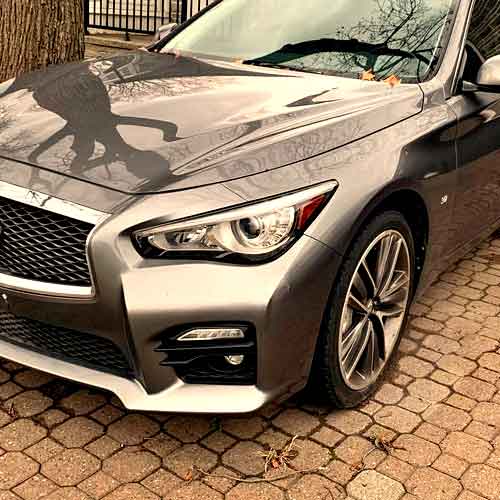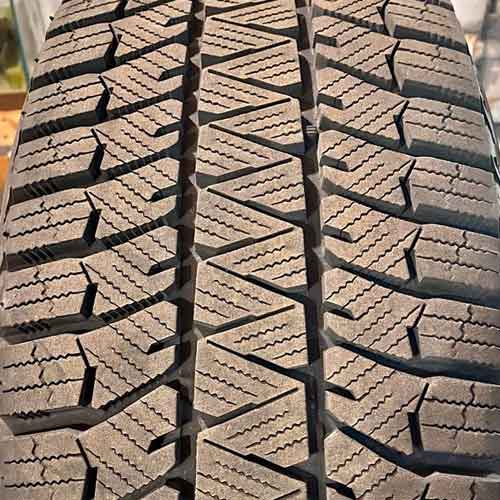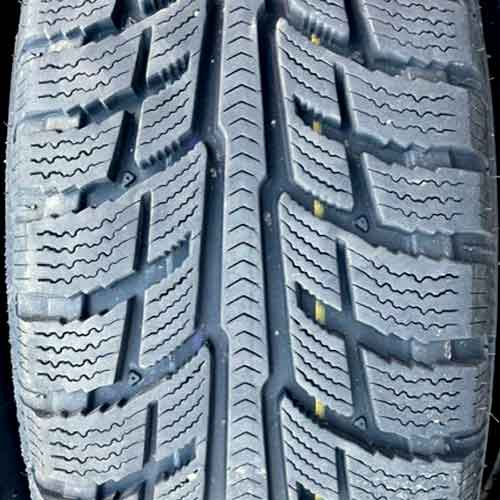The contest is on as BF Goodrich Winter T/A KSI, carrying its renowned performance in deep snow, squares off against the Bridgestone Blizzak WS90, known for its remarkable resilience against ice. When these snow titans meet, who will rule the winter roost? Well, let’s find out.

Table of Contents
Tire Sizes
The BF Goodrich Winter T/A KSI comes in 57 total sizes in 14 to 20 inches, with following specs.
- Speed ratings: H and T.
- Load ratings: SL and XL
- Tread depth: 12/32″ on all.
- Weight: 16 to 41 lbs.
- Tread warranty: standard warranty of 6 years.
On the flip side, the Bridgestone Blizzak WS90 comes in 52 total sizes in 15 to 19 inches (wheels) with following specs.
- Speed ratings: T or H.
- Load ratings: SL or XL.
- Tread depth: 11 or 12/32″.
- Weight: 17 to 29 lbs.
- Tread warranty: None.
Review this tire in greater detail: https://snowytires.com/bridgestone-blizzak-ws90-review/
Tread Appearance
The Bridgestone Blizzak WS90 is a marvel in the tire world, featuring a sturdy and well-thought-out directional tread pattern.

This design is dominated by three distinguished ribs, with the central one being continuous.
This central rib is adorned with wave-like sipes and also carries straight, interconnected ones, seamlessly integrated with in-groove notches.
Moreover, you also get V-shaped incisions here (attached to those notches, you can say). These are facing on either sides, towards shoulders.
Speaking of which, the shoulder lugs also have notches, which are slightly thicker. They are slightly slanted and facing the middle lugs.
Moreover, there are in-groove notches here as well (which may seem as splitting up the shoulder lugs). Like seen on the central rib, these notches are joined up with siping slits.
And yes, zigzag-shaped slits on the lugs add an extra layer of versatility to the design, and so does the siping, which is similar to the ones seen on central blocks, of course.
On the other hand, BF Goodrich Winter TA KSI is a pretty unique design as well.

Here, the tire’s directional tread pattern has a continuous running rib in the middle, which although is very thin, has off-set edges, and V shaped siping on it.
The surrounding lugs are actually part of shoulders, so you can see most of the tread pattern is made of these blocks, though they seem to be sightly divided up by in groove biters.
If you consider these notches closely you’d note a few things about them, one, they are “plus” shaped, with lateral arms having more aggressive zigzag edges, while longitudinal varying in width.
Moreover, these grooves have triangular stone ejectors strategically placed within them.
Other than this, you get aggressive wave-like siping on these shoulder lugs, which further get more aggressive as you move towards the tread extremities.
And yes, these shoulder blocks are joined up with each other with continuous running longitudinal rib underneath, and they are actually staggered (forming mud scoops in them).
Snow Performance
When considering proficiency in fluffy snow conditions, both tires demonstrate impressive performance. However, the BF Goodrich Winter TA KSI slightly outshines its competitor.
And delving deeper into the construction and design reveals the reasons for this advantage.
The distinguishing feature of the Winter TA KSI lies in its higher number of tread voids, primarily in the shape of in-groove notches. These notches expertly trap snowflakes, thereby improving the contact between snow particles.
This phenomenon allows the trapped snow to meet the ground as the tire rolls, enhancing grip as snow adheres better to itself than to rubber.
Moreover, as the tire features greater weight on average, the snow is pushed in more (and lodging of it becomes easier).
Additionally, the Winter TA KSI is equipped with expansive V-shaped lugs, adept at displacing heavy snow.
This results in forward propulsion as the thrown snow clears the path for the tire’s roll. This exclusive characteristic marginally improves the tire’s acceleration times.
Contrarily, the Bridgestone Blizzak WS90 demonstrates slightly less efficacy in braking and handling. Its design is more enclosed, boasting a continuous central rib and smaller in-groove notches.
Even though it exhibits a (kind-of similar) directional tread pattern, it lacks the extensive sweeping arms of its rival, reducing its snow plowing capability.
So overall, in case of snow performance, the BF Goodrich Winter TA KSI takes the lead.
Wet Traction
Wet traction primarily depends on two factors: tread design and rubber composition.
And although both tires feature great designs, with ample siping and soft tread rubbers, the Bridgestone Blizzak WS90 is still slightly ahead of the game.
The advantage of the Bridgestone Blizzak Ws90 lies in its extensive network of straight and interlocking sipes. They exhibit superior water absorption capabilities, leading to better grip in wet conditions.
And yes, here the multi-angled structure of the sipes also ensures excellent cornering and braking abilities.
Contrarily, the BF Goodrich Winter TA KSI, with its single siping design, and which are also “less-angled”, fails to provide equal overall traction, resulting in longer wet braking distances and handling times.
However, when it comes to hydroplaning resistance, the Winter TA KSI performs notably better with its wider grooves and sweeping arms, which facilitate higher float speeds in both curved and straight aqua tests.
So wet grip comes out better on Blizzak, while Hydroplaning Resistance is superior on BFG’s tire.
Ice Performance
On icy terrains, the roles are reversed, with the Bridgestone Blizzak WS90 leading the way. The tire provides a shorter braking distance by 9 feet compared to its counterpart. Moreover, the Blizzak’s acceleration is notably superior.
The reason behind this is the intricate biters spread across the tread. The central rib of the tire features varying-width slanted incisions, and when combined with V-shaped notches, they ensure excellent longitudinal ice traction.
Moreover, the tire’s multi-angled sipes further add to these biters.
Observing its tread pattern reveals two diagonally angled sipes on the rib, enhancing grip on icy terrains.
The shoulder lugs of the tire also offer biting edges in both lateral and longitudinal directions, providing comprehensive grip. These shoulder blocks notably enhance handling capabilities, displaying faster steering feedback and reduced handling times.
On the other hand, the BF Goodrich Winter TA KSI has wider tread voids, which fail to grip ice as effectively.
The lack of notches and multi-angled siping on both central and shoulder lugs also lead to a longer average braking distance and handling time.
So overall Ice performance comes out better for Blizzak WS90.
Dry Traction
Dry grip efficiency largely depends on the tire’s contact area with the ground, with directional grip and lateral traction playing key roles.
In this regard, the Bridgestone Blizzak WS90, with its “wider” central continuous central rib, has an advantage.
This allows for better and more consistent ground contact, particularly on highways, leading to shorter braking distances and quicker acceleration times.
Moreover, the lighter weight of the Blizzak WS90 is also a contributing factor here and offers superior handling. This is because, while corners, it’s lugs aren’t forced to bend a lot, leading to faster handling feedback compared to BFG.
So overall Dry Traction is seen better on Blizzak.
Fuel Economy
The fuel efficiency of tires is closely related to their grip on the road and their overall weight.
Here, the BF Goodrich Winter TA KSI could use some improvement.
What I mean is that the tire’s substantial weight and broader tread voids increases its rolling resistance and friction with the road surface.
Whereas, the lighter Blizzak WS90 exerts less pressure on the road, reducing overall friction.
And yes, it’s longitudinally aligned tread ribs streamline with the tire’s direction, reducing obstacles to movement, saving energy, and improving fuel economy.
Comfort Levels
The comfort of a tire largely stems from elements such as road noise and vibration dampening. These characteristics are largely dictated by the tire’s construction, the materials used, the tread pattern, and the sidewall design, which mainly determines the smoothness of cornering.
Speaking on noise first, which gets generated with air particles hitting around the tread, the Bridgestone Blizzak Ws90 takes the lead with its less voided tread design. With this air particles colliding with the tread walls, don’t have enough room.
(But please note, the overall difference between the two tires is not a lot).
And yes, the BF Goodrich Winter TA KSI does great in the 2nd part of overall comfort. It provides a slightly smoother ride due to its superior shock absorption over bumps. Thus, taking all factors into account, both tires offer similar comfort levels.
So you can say, overall both tires do okay here, and are rated as equals.
Tread Life
Tread life heavily depends on rolling resistance, especially in the case of these two tires.
Here, the Blizzak WS90 takes the upper hand.
Its lighter weight exerts less force on the tread blocks as they contact the road, resulting in less friction and slower rubber wear.
Conversely, the heavier BF Goodrich Winter TA KSI concentrates its additional weight onto a smaller rubber surface due to its wider tread voids.
This puts more strain on each lug, accelerating tread wear and reducing its overall lifespan. However, the performance difference between the two tires is relatively small, hence the lack of warranties.
To Conclude
In terms of snow performance, the BF Goodrich Winter TA KSI outshines with its distinctive tread design and higher count of tread voids, providing superior snow grip and clearance.
However, under icy conditions, the Bridgestone Blizzak WS90 excels, due to its complex biters, angled cuts, and multi-angled sipes that provide enhanced traction and handling.
On wet surfaces, the Blizzak dominates in terms of grip, while the BF Goodrich Winter TA KSI stands out for hydroplaning resistance.
Yet, overall, the Blizzak WS90 seems to be a slightly better choice due to its quieter performance and better fuel and tread economy.